
Photo: NextCity
A Philadelphia street scene
The ideas of writer Jane Jacobs, well-known for her influence on city planning, continue to be tested. Is it true, for example, that having a lot of “eyes on the street” reduces crime? Jared Brey writes at NextCity about efforts in Philadelphia to find out.
“In the five-and-a-half decades since Jane Jacobs published The Death and Life of Great American Cities, her core contention — that urban vitality and safety are a function of small-scale density, a mixture of uses and ‘eyes on the street’ — has become conventional wisdom in urban theory. …
“In June, a team of researchers released a paper, titled ‘Analysis of Urban Vibrancy and Safety in Philadelphia,’ that attempts to begin a quantitative analysis of Jacobsian theory by bringing together publicly available data sets related to crime, business activity and the built environment. The study is the first of a series they have planned.
“In order to test the ‘eyes on the street’ notion, the authors — three statisticians at the Wharton School at the University of Pennsylvania and an architect — investigated the correlations between public safety and population density, population count, zoning, business activity, and business hours. They also designed a model of ‘business vibrancy,’ meant to serve as a proxy for Jacobs’ concept of eyes on the street, based on the density of businesses in certain areas and the amount of ‘excess business hours’ on them — meaning blocks with businesses open longer than what the authors calculated to be the citywide average. …
“Among the authors’ findings:
* Population density is not as strongly associated with crime rates as population count.
* More crimes occur on blocks with more businesses, but fewer in the direct vicinity of businesses that have longer-than-average operating hours.
* Crime rates are higher in neighborhoods with high rates of vacancy, but within high-vacancy neighborhoods, fewer crimes are reported in the direct vicinity of vacant properties. …
“ ‘What it says is measuring human activity is subtle and difficult,’ [co-author Shane Jensen, a statistics professor at Wharton,] says. ‘Yes, it does seem like there is something to this concept of eyes on the street, but I don’t think it’s just as simple as making sure that there’s businesses on every street corner and stuff like that. If anything, the more high-resolution you break this down, the more insight you can glean.’ ” More at NextCity.
Here’s my question: as online shopping causes retail storefronts to close, how do we preserve any “eyes on the street” at all?

